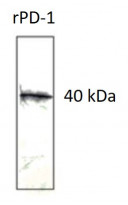anti-CD279 / PD-1 antibody [7C9]
CAT.NO. : ARG11038
US$ Please choose
US$ Please choose
Size:
Trail, Bulk size or Custom requests Please contact us
概述
| 产品描述 | Mouse Monoclonal antibody [7C9] recognizes CD279 / PD-1 |
|---|---|
| 反应物种 | Hu |
| 应用 | I-ELISA, WB |
| 特异性 | Reactive with recombinant human programmed cell death-1 (PD-1). Reactivity with natural PD-1 has not been evaluated. |
| 宿主 | Mouse |
| 克隆 | Monoclonal |
| 克隆号 | 7C9 |
| 同位型 | IgG1, kappa |
| 靶点名称 | CD279 / PD-1 |
| 抗原物种 | Human |
| 抗原 | 40 kDa recombinant Human PD-1. |
| 偶联标记 | Un-conjugated |
| 別名 | hPD-l; CD279; PD-1; Protein PD-1; CD antigen CD279; PD1; hSLE1; SLEB2; Programmed cell death protein 1; hPD-1 |
应用说明
| 应用建议 |
| ||||||
|---|---|---|---|---|---|---|---|
| 应用说明 | sELISA: Recommended pairs (capture - detection): ARG11038 anti-CD279 / PD-1 antibody [7C9] - ARG11041 anti-CD279 / PD-1 antibody [7G12] * The dilutions indicate recommended starting dilutions and the optimal dilutions or concentrations should be determined by the scientist. |
属性
| 形式 | Liquid |
|---|---|
| 纯化 | Purification with Protein G. |
| 缓冲液 | PBS (pH 7.2) |
| 浓度 | 1 mg/ml |
| 存放说明 | For continuous use, store undiluted antibody at 2-8°C for up to a week. For long-term storage, aliquot and store at -20°C or below. Storage in frost free freezers is not recommended. Avoid repeated freeze/thaw cycles. Suggest spin the vial prior to opening. The antibody solution should be gently mixed before use. |
| 注意事项 | For laboratory research only, not for drug, diagnostic or other use. |
生物信息
| 数据库连接 | |
|---|---|
| 基因名称 | PDCD1 |
| 全名 | programmed cell death 1 |
| 背景介绍 | CD279 / PD-1 is a cell surface membrane protein of the immunoglobulin superfamily. This protein is expressed in pro-B-cells and is thought to play a role in their differentiation. In mice, expression of this gene is induced in the thymus when anti-CD3 antibodies are injected and large numbers of thymocytes undergo apoptosis. Mice deficient for this gene bred on a BALB/c background developed dilated cardiomyopathy and died from congestive heart failure. These studies suggest that this gene product may also be important in T cell function and contribute to the prevention of autoimmune diseases. [provided by RefSeq, Jul 2008] |
| 生物功能 | CD279 / PD-1 is an inhibitory receptor on antigen activated T-cells. It plays a critical role in induction and maintenance of immune tolerance to self (PubMed:21276005). Delivers inhibitory signals upon binding to ligands CD274/PDCD1L1 and CD273/PDCD1LG2 (PubMed:21276005). Following T-cell receptor (TCR) engagement, PDCD1 associates with CD3-TCR in the immunological synapse and directly inhibits T-cell activation. Suppresses T-cell activation through the recruitment of PTPN11/SHP-2: following ligand-binding, PDCD1 is phosphorylated within the ITSM motif, leading to the recruitment of the protein tyrosine phosphatase PTPN11/SHP-2 that mediates dephosphorylation of key TCR proximal signaling molecules, such as ZAP70, PRKCQ/PKCtheta and CD247/CD3zeta. The PDCD1-mediated inhibitory pathway is exploited by tumors to attenuate anti-tumor immunity and escape destruction by the immune system, thereby facilitating tumor survival (PubMed:28951311). The interaction with CD274/PDCD1L1 inhibits cytotoxic T lymphocytes (CTLs) effector function (PubMed:28951311). The blockage of the PDCD1-mediated pathway results in the reversal of the exhausted T-cell phenotype and the normalization of the anti-tumor response, providing a rationale for cancer immunotherapy (PubMed:22658127, PubMed:25034862, PubMed:25399552). [UniProt] |
| 产品亮点 | Related products: PD-1 antibodies; PD-1 ELISA Kits; PD-1 Duos / Panels; Anti-Mouse IgG secondary antibodies; Related news: The best solution for PD-1/PD-L1 research Examining CTL/NK-mediated cytotoxicity by ELISA |
| 预测分子量 | 32 kDa |
检测图片 (2)
ARG11038 anti-CD279 / PD-1 antibody [7C9] WB image
Western blot: 1 µg of recombinant Human PD-1 stained with ARG11038 anti-CD279 / PD-1 antibody [7C9] at 1 µg/ml dilution.
ARG11038 anti-CD279 / PD-1 antibody [7C9] standard curve image
ARG11038 anti-CD279 / PD-1 antibody [7C9] results of a typical standard run with optical density reading at 450 nm.
 New Products
New Products




![anti-CD279 / PD-1 antibody [7C9]](/upload/image/products/ARG11038_ELISA_1_210_205.jpg)
![anti-CD279 / PD-1 antibody [7C9]](/upload/image/products/ARG11038_WB_1.jpg)
![anti-CD279 / PD-1 antibody [7C9]](/upload/image/products/ARG11038_ELISA_1.jpg)
















